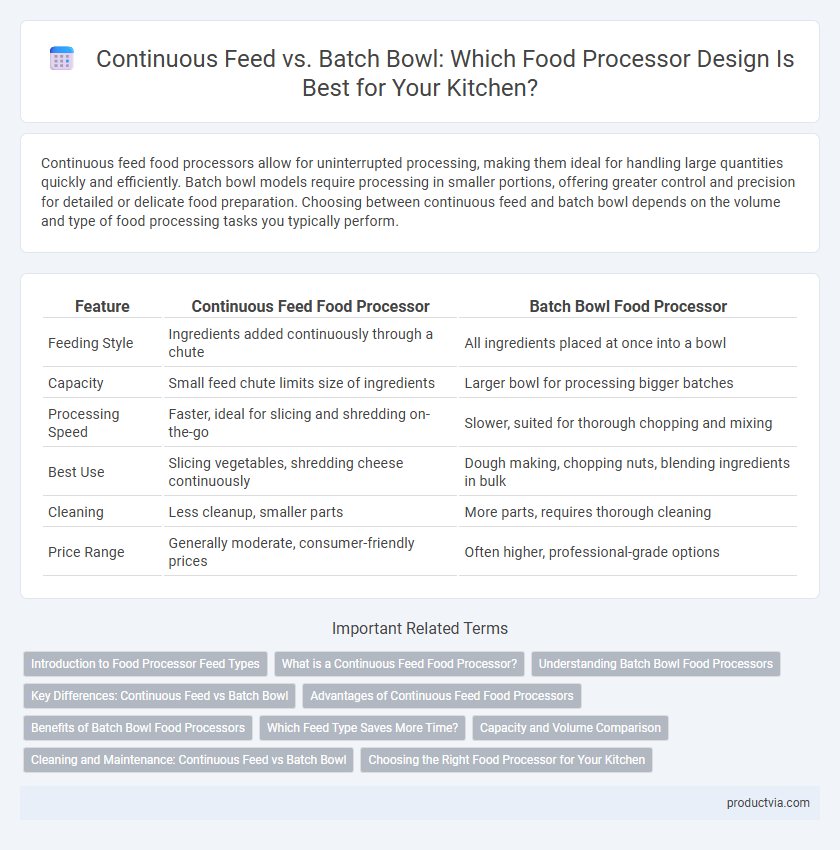Continuous feed food processors allow for uninterrupted processing, making them ideal for handling large quantities quickly and efficiently. Batch bowl models require processing in smaller portions, offering greater control and precision for detailed or delicate food preparation. Choosing between continuous feed and batch bowl depends on the volume and type of food processing tasks you typically perform.
Table of Comparison
| Feature | Continuous Feed Food Processor | Batch Bowl Food Processor |
|---|---|---|
| Feeding Style | Ingredients added continuously through a chute | All ingredients placed at once into a bowl |
| Capacity | Small feed chute limits size of ingredients | Larger bowl for processing bigger batches |
| Processing Speed | Faster, ideal for slicing and shredding on-the-go | Slower, suited for thorough chopping and mixing |
| Best Use | Slicing vegetables, shredding cheese continuously | Dough making, chopping nuts, blending ingredients in bulk |
| Cleaning | Less cleanup, smaller parts | More parts, requires thorough cleaning |
| Price Range | Generally moderate, consumer-friendly prices | Often higher, professional-grade options |
Introduction to Food Processor Feed Types
Continuous feed food processors feature a chute that allows ingredients to be added incrementally while the machine operates, enhancing efficiency in processing large quantities. Batch bowl food processors require loading all ingredients at once before processing, offering greater control for smaller tasks or precise chopping. Understanding the differences in feed types helps users select the appropriate model based on cooking frequency and recipe complexity.
What is a Continuous Feed Food Processor?
A continuous feed food processor features a tall feed chute that allows ingredients to be added continuously while the machine is running, enabling efficient processing without stopping. This design increases productivity and is ideal for large quantities or repetitive tasks such as slicing, shredding, and grating. Continuous feed models typically offer greater convenience and speed compared to batch bowl processors, which require stopping to add ingredients.
Understanding Batch Bowl Food Processors
Batch bowl food processors require the user to manually add ingredients in portions, offering precise control over chopping, slicing, and mixing tasks. These processors excel in handling large quantities at once, making them ideal for preparing doughs, batters, and bulky vegetables. Understanding the batch bowl mechanism helps optimize processing efficiency and prevents overloading, ensuring consistent texture and quality.
Key Differences: Continuous Feed vs Batch Bowl
Continuous feed food processors feature a narrow chute that allows ingredients to be added while the machine runs, speeding up processing and enhancing efficiency. Batch bowl food processors require ingredient loading before processing, offering larger capacity and better precision for chopping and mixing tasks. The choice depends on kitchen workflow, with continuous feed models suited for quick, repetitive tasks and batch bowls ideal for handling larger or more complex recipes.
Advantages of Continuous Feed Food Processors
Continuous feed food processors offer significant time-saving benefits by allowing users to process large quantities of ingredients without stopping to reload, enhancing efficiency in meal preparation. They typically feature a wider feed chute that accommodates whole fruits and vegetables, reducing the need for pre-cutting and streamlining the workflow. This design supports multitasking and consistent results, making continuous feed food processors ideal for both home cooks and professional chefs seeking speed and convenience.
Benefits of Batch Bowl Food Processors
Batch bowl food processors offer precise control over ingredient processing, making them ideal for tasks that require detailed chopping, mixing, or blending in smaller quantities. Their compact design facilitates easy handling and cleaning, improving overall kitchen efficiency. The versatility of batch bowls supports a wide range of culinary techniques, enhancing recipe accuracy and consistency.
Which Feed Type Saves More Time?
Continuous feed food processors save more time by allowing ingredients to be added while the machine is running, enabling uninterrupted processing and reducing preparation duration. Batch bowl processors require stopping to add ingredients, which can extend overall processing time due to frequent pauses. For large or complex recipes, continuous feed models provide greater efficiency and faster task completion.
Capacity and Volume Comparison
Continuous feed food processors typically offer larger capacity and higher volume throughput, allowing ingredients to be processed without stopping, ideal for bulk food preparation. Batch bowl food processors have a fixed, often smaller bowl size, requiring users to stop and refill between batches, limiting volume but providing more precise control for smaller quantities. Capacity considerations favor continuous feed models for efficiency, while batch bowls excel in handling varied, smaller volumes with greater accuracy.
Cleaning and Maintenance: Continuous Feed vs Batch Bowl
Continuous feed food processors typically feature a large chute that allows ingredients to be added continuously, making cleaning more challenging due to food residue buildup inside the feed tube and pusher. Batch bowl models tend to have fewer components and a wider opening, simplifying disassembly and thorough washing of parts, which reduces maintenance time and effort. Proper cleaning of continuous feed processors requires attention to crevices in the chute mechanism, while batch bowl processors allow for easier access to blades and bowls, enhancing overall hygiene and durability.
Choosing the Right Food Processor for Your Kitchen
Continuous feed food processors excel in handling large quantities of ingredients quickly, featuring a tall feed tube that allows for nonstop chopping and slicing. Batch bowl processors offer greater control over food size and texture, ideal for smaller tasks and precision work with their wider, lower bowls. Selecting the right food processor depends on kitchen needs, with continuous feed models suited for speed and volume, while batch bowls prioritize versatility and exactness.
Continuous feed vs batch bowl for food processor Infographic

 productvia.com
productvia.com